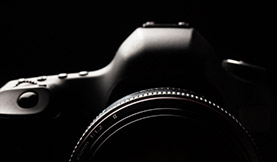Video Tutorial: Creating a Traveling Highlight “Ken Burns style” in Avid Media Composer
In this video tutorial, you’ll explore how to replicate the famous “highlight-and-zoom” effect, made famous by documentarian Ken Burns.
This Avid Media Composer video tutorial will show you how to:
- Zoom in on an area of a still photograph using the Resize effect
- Autonest a 3D Warp effect to combine multiple effects
- Adjust the Highlight and Shape parameters within the 3D Warp effect to create the appropriate highlight effect
- Use keyframes to animate the effect to match the zoom (“Ken Burns style”)
- Save the effect template for later use
Full Video Transcriptions
Hello, this is Ashley Kennedy from www.PremiumBeat.com here to show you how to perform an often used documentary trick, made famous by Ken
Burns. Casting a highlight in an area of the frame usually to bring emphasis to a certain person or object. In Avid Media Composer it’s pretty easy to do using the highlight parameter within the 3D warp effect. Here I have a photo of the University of Illinois 1952 Rose Bowl team. This guy right here is my grandfather, and if I’m making a documentary about him, what I’d like to do is bring emphasis to him as I zoom in on him. I want to highlight him, while I’m zooming in on the whole photo. I’m going to show you how to do that.
First of all, we need to perform the zoom in. There’s many ways to do this. Probably the best way to do it is to use the Avid pan and zoom effect, but that’s a whole other tutorial. I’m going to do it using a method that’s a little bit easier, and probably something you already know, just a resize I’m just going to grab resize and put it on my video track. Open up my effect editor, and let’s go ahead and add a key frame at the beginning, and I’ll add a keyframe right here, a little bit before the end, and then another one at the end, like so. What we want to do is go ahead and make sure that we crop off the sides. So I’ll zoom in just a little bit at the beginning, put our fixed aspect on, so, that will be our first frame. Then, we come here, and this is where we want the zoom to end. I’m just going to zoom in and then reposition. OK. So, we’ll have the highlight basically go from here to here. Then what we want to do is let it stay at this size for the last second or so. So, I’m just going to copy the parameters here, command C, or control C if I was on a PC, and paste them here, command V.
Let’s just take a look at the zoom and see if we like it. This is over about five seconds, by the way. We’re holding at the end. Looks good. Maybe I want to move this over just a little bit. Again, that’s an option drag, or alt drag if I was on a PC. That looks good. We have the zoom part of this finished. Go ahead and close the effects editor. The next thing you want to do is add a 3D warp effect to this. OK? There’s a couple of ways to do this. The easiest way to do this is to auto-nest the 3D warp effect. Let’s grab our 3D warp effect in the blend category. Auto-nesting simply means that we are putting an effect on top of another effect. You do this by option dragging the 3D warp effect, on top. We can check that there are two effects in there by double-clicking. So, here’s my re-size, and here’s my 3D warp.
Now, what we want to do is open up the effect editor, and the parameter that we’re going to be using is the highlight parameter. Here it is. I’m just going to open that up and enable it. It doesn’t look too good right away, but we’re going to fix that. First of all, let’s go ahead and make sure that we are at the beginning. We’ll add a key frame here, and match up when the movement stops, which is about right here for the key frame. And another one at the end for the hold. I’m actually going to press command A to select all key frames, because we want to start this out effected across the entire effect. We’ll change that later. We have the highlight. It looks like a milky white blob, but, again, that will improve. We’ll go ahead and move it over using the X and Y. Good. Adjust the softness, intensity, and radius.
Now, I don’t actually like this. What I really want to do is reverse the highlight so that everything else is dark and this are over my grandfather is normal. So, what we want to do in order to do a reverse highlight, it’s kind of funny, but it works. I open up the shape parameter and I have to enable it. It looks very strange because right now I have a page fold on, but don’t worry, we’ll fix that. I change auto highlight, which is what we’re on right now, to reverse manual highlight. Then, I’m just going to deselect shape. So, this is a little bit more what I want. I have everything else kind of dimmed out, and I have this area that is at normal exposure. I’m going to play through it. Again, the highlight isn’t traveling yet, but we will fix that. We’re zooming. What we need to do is actually make this become larger, and move it over just a little bit. I’ll probably up the intensity as well.
We’ll come over to our next keyframe and manipulate some of these parameters. We’ll move it over and up, get our radius bigger, and, again, we want to kind of darken everything else a little bit more. That’s looking pretty good. Let’s see how it animates. OK. That looks good. At the very end there all we need to do is copy and paste the key frame parameters. Again, that’s a command C, and command V to paste the parameters from here to here since we’re just holding. Alright, so let’s take a look. This should be our final effect. OK. James Catlin, number 67, of the 1952 Rose Bowl team, highlighted in this group, appropriately using the Ken Burns traveling highlight effect.
What if you want to save this out and use it again for other similar highlights in your show? Well, we’re just going to come over here and create a new bin. I’m going to call it “effects.” I’m just going to drag the effect icon here, and I’m going to call this “highlight.” Now, in Media Composer the highlight will only save the first parameter, not the entire traveling highlight. So, you’ll, of course, have to do some tweaking for future animations if you want to put this in other places in your show. But, you’ve at least given yourself a head start as far as the highlight parameters are concerned. There you have it. As you can see, we’ve been able to fairly quickly replicate the Ken Burns highlight and zoom effect. Practice on your own and feel free to tweak the parameters to your own liking. Remember to check back regularly at Premiumbeat.com for other screencasts where we explore lots of exciting techniques in both Avid and Final Cut Pro. This is Ashley Kennedy with Premiumbeat.com.





